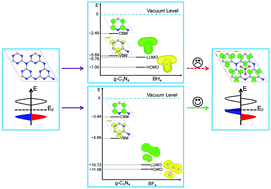Designing half-metallic ferromagnetism by a new strategy: an example of superhalogen modified graphitic C3N4†
Abstract
Designing half-metallic ferromagnetism at atomic scale is always one of the hottest topics for the scientific community due to its potential in spintronics applications. Although the band alignment strategy is broadly adopted in semiconductor-based research, it has not touched the field of low-dimensional spintronics. Here, taking graphitic C3N4 (g-C3N4) as an example, we show that perfect half-metallic ferromagnetism can be realized through a band alignment strategy. According to the alignment of the valence band maximum (VBM) and the conduction band minimum (CBM) of g-C3N4, and the highest occupied molecular orbital (HOMO) and the lowest unoccupied molecular orbital (LUMO) of superhalogens, BF4 is predicted to be a promising building unit which induces half-metallic ferromagnetism in the g-C3N4 sheet by forming hybrid structures. Verified by density functional simulations, we found that a net magnetic moment of 1 μB per BF4 is induced in the g-C3N4 sheet. The magnetic moment distributes evenly on the double-coordinated nitrogen atoms with ferromagnetic coupling, and dynamics simulations confirmed that the structure of g-C3N4 is well protected. Thus, our study proposes a promising way to design half-metallic ferromagnetism at atomic scale, which will evoke further experimental interest.



 Please wait while we load your content...
Please wait while we load your content...